Leading with PACE: Better Business Impact without the Burnout
 With news that South Africa faces a real slowdown in terms of economic growth for 2014 and forecast for even greater downward trends in 2015, the questions become, "How does one do more with less? How does one run a business which can create a better business impact without increasing the burnout of one's employees and one's self?"
There is a new model for leadership which addresses these things. It is called PACE based leadership. Its philosophical underpinnings are grounded in four new leadership practices which take into account the need to create greater traction with less resources. Leading with PACE focuses on Play, Agility, Curiosity and Energy to achieve this.
With news that South Africa faces a real slowdown in terms of economic growth for 2014 and forecast for even greater downward trends in 2015, the questions become, "How does one do more with less? How does one run a business which can create a better business impact without increasing the burnout of one's employees and one's self?"
There is a new model for leadership which addresses these things. It is called PACE based leadership. Its philosophical underpinnings are grounded in four new leadership practices which take into account the need to create greater traction with less resources. Leading with PACE focuses on Play, Agility, Curiosity and Energy to achieve this.
 When leaders adopt a playful mindset to the work which needs to get done, they become more comfortable in a world where boundaries aren't clearly defined and the landscape changes at a rate which is difficult to predict. It is not so much about building play activities into one's job. It is more about reminding oneself that when one is playful, we bring a sense of the present, of being mindful in the moment and a sense of focus to the work we are engaged in.
When leaders adopt a playful mindset to the work which needs to get done, they become more comfortable in a world where boundaries aren't clearly defined and the landscape changes at a rate which is difficult to predict. It is not so much about building play activities into one's job. It is more about reminding oneself that when one is playful, we bring a sense of the present, of being mindful in the moment and a sense of focus to the work we are engaged in.
There has always been a misguided comfort in the belief that the Business of Business is Business. Unfortunately this kind of thinking leaves one open to the very real danger of Overseriousness where work no longer feels like an adventure, where we start feeling cynical about the processes we are engaged in, disconnected from our colleagues, fueled with fatigue at what lies ahead and scared of taking risks and innovating beyond the known.
For Lego, the largest toy company in the world, when we adapt a playful approach, when we remember the joy of seeing work as play, as the place where we don't know the outcome of our endeavour, our attitudes change; we become more courageous and realigned to the work we do.
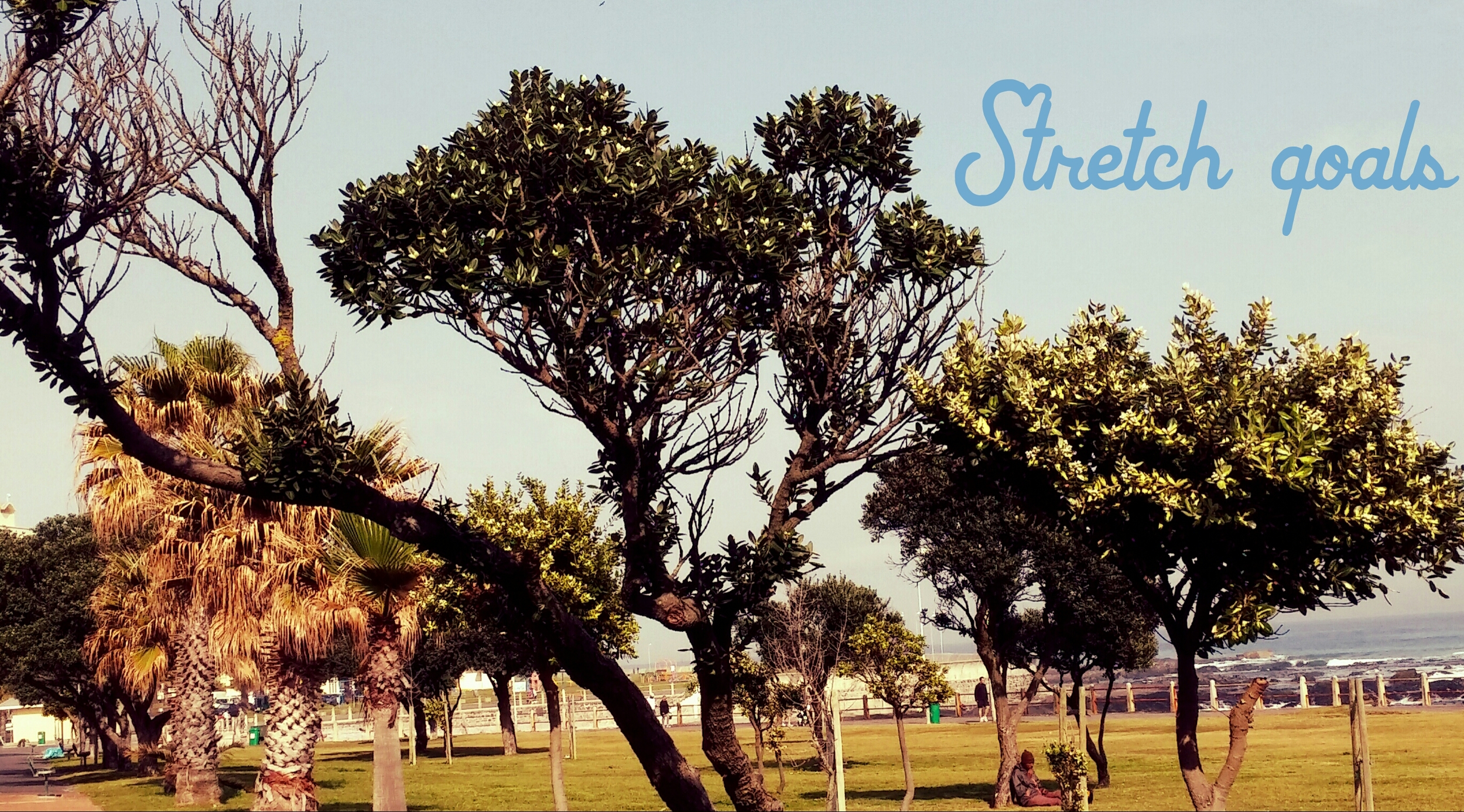 Agility, the second part of the Pace based leadership model reminds us that being comfortable with changing course mid-direction is an important leadership quality to be able to call on. Apple is notorious for driving its professionals crazy for their constant mid directional changes. They are however changes which have built it into the most admired company, according to Forbes, in the world. Agile leaders are able to better mitigate their risks and hear the footsteps of the future approaching. Being agile, like being playful, is never just about one decision. It is an approach to leading.
Agility, the second part of the Pace based leadership model reminds us that being comfortable with changing course mid-direction is an important leadership quality to be able to call on. Apple is notorious for driving its professionals crazy for their constant mid directional changes. They are however changes which have built it into the most admired company, according to Forbes, in the world. Agile leaders are able to better mitigate their risks and hear the footsteps of the future approaching. Being agile, like being playful, is never just about one decision. It is an approach to leading.
Curiosity, the third piece to the PACE model of leadership, is an enabler of agile and playful practices. When we are curious, we notice other opportunities, we let go of our assumptions and make better commercial decisions; curious leaders are more able to rid themselves of dogma, prejudice and judgement. Being able to notice helps us to unlearn, to begin again in the middle, if need be.
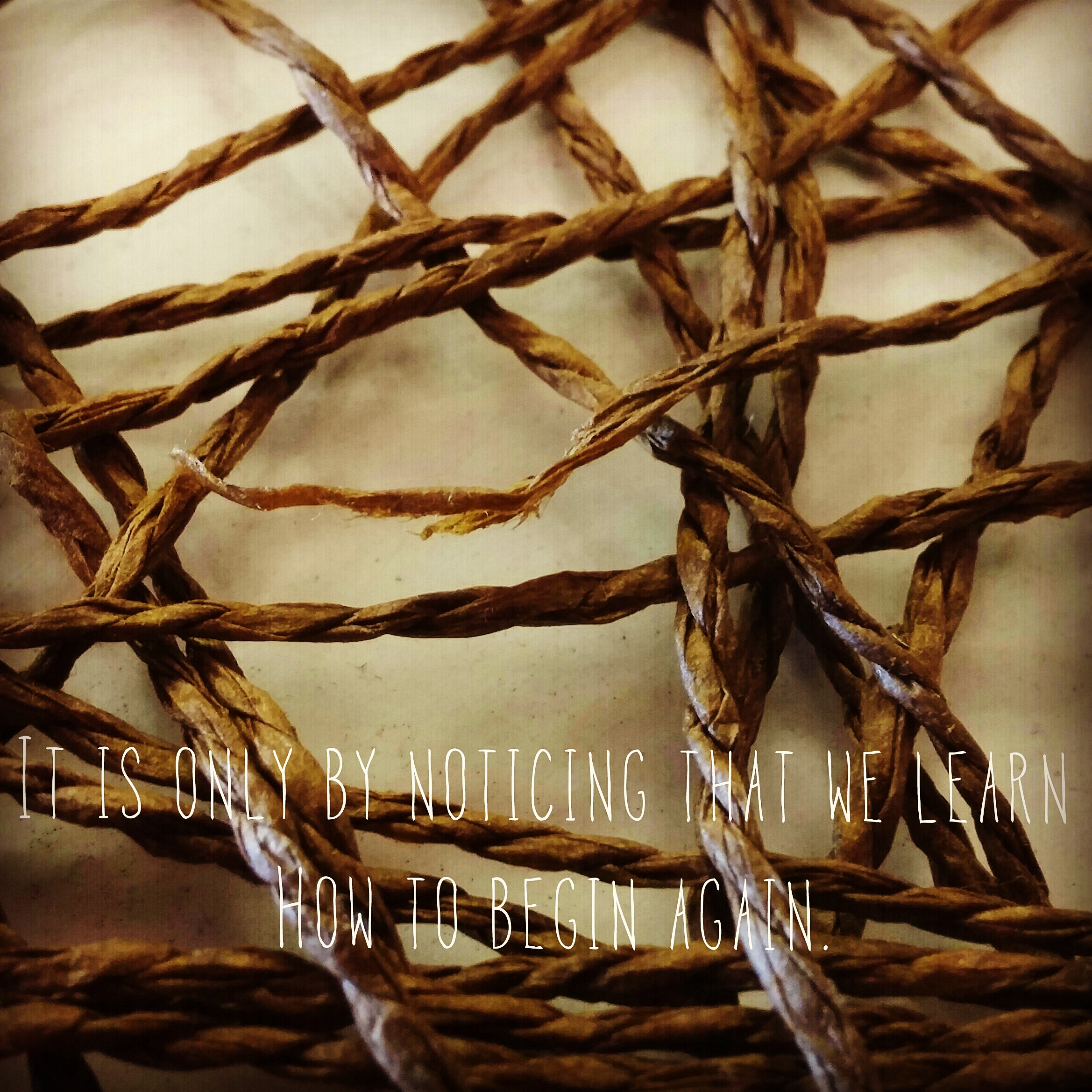 When we lead with PACE, we lead at a rate that feels resonant for each and every one of us. It requires that we change our mindset from focusing on the time we have available to the energy required to complete the task at hand.
When we lead with PACE, we lead at a rate that feels resonant for each and every one of us. It requires that we change our mindset from focusing on the time we have available to the energy required to complete the task at hand.
Leading with PACE gives us the tools to reframe our thinking, engage and connect meaningfully with others and avoid the burnout so often associated with trying to match the speed of the environment we are operating in. It provides counter tools to the traditional methods of control and command and enables leaders to reshape their leadership challenges with energy, ease and insight.
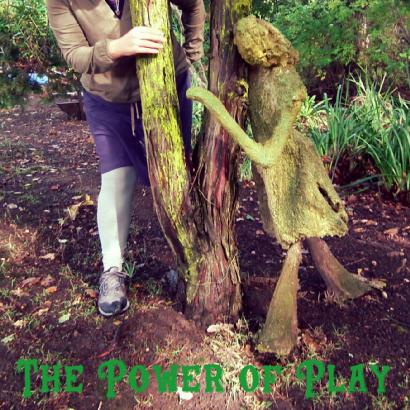 Elaine Rumboll has developed a one day masterclass on Leading with PACE. The programme has been designed for organisations looking to generate a more meaningful impact through less resources, and to gain more traction through a more fulfilling way of leading and doing. For a detailed description of what the masterclass entails, download the pdf here.
Elaine Rumboll has developed a one day masterclass on Leading with PACE. The programme has been designed for organisations looking to generate a more meaningful impact through less resources, and to gain more traction through a more fulfilling way of leading and doing. For a detailed description of what the masterclass entails, download the pdf here.
The Dangers of Overseriousness
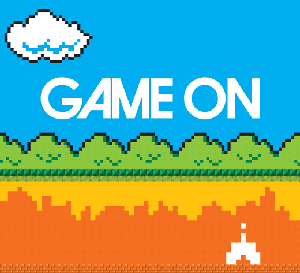 It is ironic that we are hard wired to include the word 'fear' when we speak of Uncertainty - the fear of the unknown, fear of failure, fear of judgement. However if we look at artistic and entrepreneurial practice, all efforts at innovation, creativity and engagement come from a place of NOT knowing what the outcome will be. It is in this place of not knowing that we create, connect and innovate. It seems that it is the nature of creativity to come from a place of uncertainty.
History is peppered with stories of people who started off believing they were inventing one thing and ended up inventing another. It is precisely this uncertainty which is at the heart of innovation which allows for something different to emerge when we trust the process and allow it to unfold into what can be.
It is ironic that we are hard wired to include the word 'fear' when we speak of Uncertainty - the fear of the unknown, fear of failure, fear of judgement. However if we look at artistic and entrepreneurial practice, all efforts at innovation, creativity and engagement come from a place of NOT knowing what the outcome will be. It is in this place of not knowing that we create, connect and innovate. It seems that it is the nature of creativity to come from a place of uncertainty.
History is peppered with stories of people who started off believing they were inventing one thing and ended up inventing another. It is precisely this uncertainty which is at the heart of innovation which allows for something different to emerge when we trust the process and allow it to unfold into what can be.
There is however another place where uncertainty is inherent in the system but does not bring with it the accompanying feeling of fear. That is in the place of Play. When we play, we have no idea of what the outcome will be. Play is always accompanied by uncertainty, not knowing what the end result will look like. However Play is also fun. It is an immersive experience of flow, of being energised in the moment and losing oneself in the joy of an experience. When we try to control the outcome of an experience, we go out of Play and into a place of performance anxiety.
There is a direct relationship between playing well and leading well in business today. Both have uncertainty as systemic in their systems. We no longer operate in environments where we can clearly delineate the boundaries of our operations, our competitors often come from disparate industries. If one attempts to lead in this environment with an 'overseriousness', the consequences are dire. We run the risk of creating stifling environments because people become scared to immerse themselves in the uncertainty and just stick to the well traveled path. By not equating work with a place of fun, of emergence we run the risk of getting stuck in systems that are mediocre, we run the risk of increasing bureaucracies. When you replace overseriousness with the spirit of play, it does not mean that you are not accountable for results: scores are part of the game.
At work, we want fully engaged teams that understand their roles in the state of play, where we don't assume fixed odds. No game is ever predictable so why do we treat our businesses as if they are?
We talk so much about teams, rewards, awards, competition in the jargon of business but the direct concept of Play even in its structured form is considered anathema to the 'serious business' of business. Consider a game like football, where all the players are expected to be in top form, but yet the outcome of each game is unpredictable. It wouldn't be exciting if people couldn't be trusted to improvise and take the risks necessary to achieve extraordinary outcomes.
What could Leadership look like if we treated it as a state of Play?
A playful leader energises other by bringing with them a sense of infectious fun, challenge, and the possibility of glorious achievement. The team’s flow and sense of involvement is more important than any individual act. The spirit of the game is all important - it is here where both the rules of the games and the relationships in the game matter.
Improvisation would be encouraged. We would allow for stellar acts of personal achievement - which we would reward and celebrate. Camaraderie and the spirit of fair play would be emphasised over the achievement of results at all costs. Here opportunities for people to connect matter . For one cannot play well together unless you connect well together. It is no small irony that the first thing to go when budgets are tight are the social activities. However, these are not indulgences, or frivolities but critical to the heart of play and possibility.
In Play we see other options. Sometimes playing through our most difficult challenges allows us to see other solutions as I so often see in the Lego Serious Play coaching I do. So if you want to avoid the dangers of overseriousness, which brings with it disengagement, mediocrity as a result of fear of failing, and bloated bureaucracies, embrace Play as a powerful leadership tool.
How PACE based leadership can energise your business
How often have you been requested to a meeting and dreaded it? Not just because of the fact that they often tend to be dreary and unproductive but also because they are seldom a place for sparking anything new. This is often because people come to meetings stuck in a particular position or mindset. I have developed a model which can, among other things, be applied to renergise a meeting place. It is based on work I have developed around what I have termed PACE based Leadership. The approach draws on four key leadership practices which are required to build highly functional teams, perspectives to be used when grappling with challenges and rethinking new approaches to things. At the heart of PACE based leadership is the emphasis on Play, Agility, Curiosity and Energy as critical leadership practices for today. Leading at PACE is a counter to the attempt to work faster in order to deal with the every increasing complexities and uncertainties of modern day business. For if we understand how to Play, embrace our own curiosity, learn to be more adaptable in the work we do and focus more on managing our energy than our time, the level of resonance and quality of our output is bound to improve.
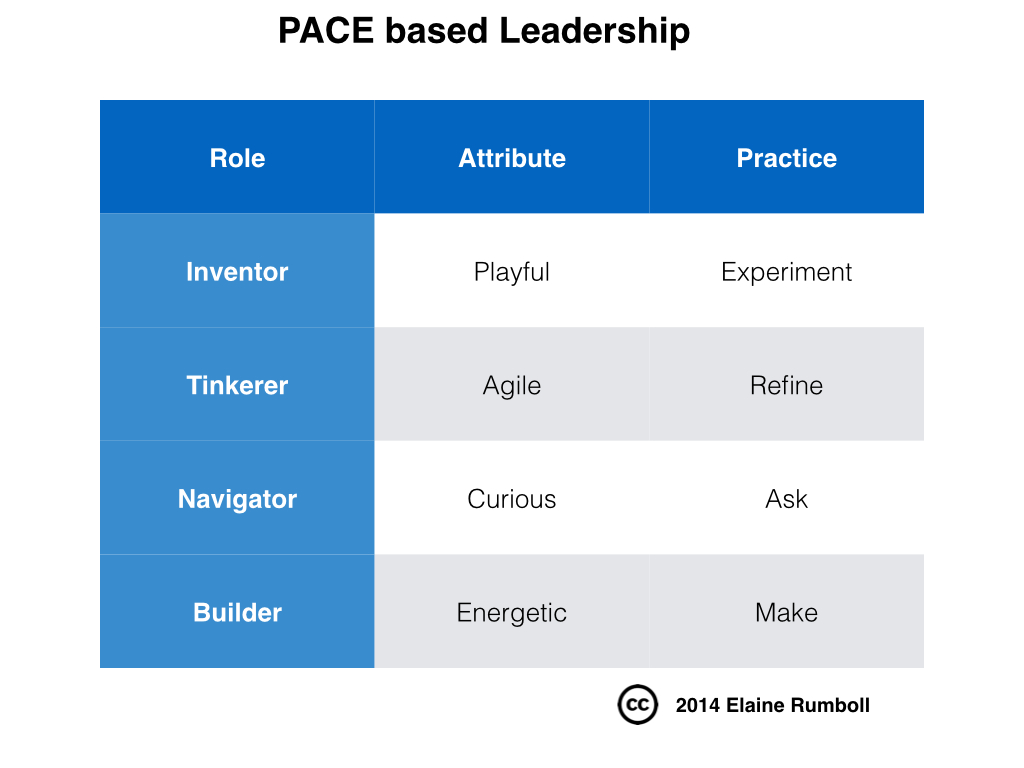 Inventors dream up new products, services and processes.
Inventors dream up new products, services and processes.
Tinkerers adapt and improve on the services and products offered.
Navigators set the direction, whilst ensuring the selection, cohesion and synthesis of all the elements
Builders turn ideas into executionable realities
I think that each of these roles requires a focus on a very particular leadership practice in order for their efforts to be effective and sustainable.
Navigators must be Curious
Proust said, "In order to discover new land, one must lose sight of the shore for a very long time". One of the dangers of being a leader is how easy it is to lose sight of one's own role. Power has a fascinating way of making people believe they are invincible, above the morals of lesser mortals; there is also a tendency to believe that one's own solutions are the correct ones. What a healthy dose of curiosity does is to allow for one to be less dogmatic, see other opportunities and other perspectives whilst increasing commercial acumen and mitigating risk. Be fascinated by your own ignorance and see what changes for you.
Tinkerers must be Agile
When one is required to improve a system or change a process, the default response is to look to where it has worked best elsewhere. The danger in this is that each organisation has an internal readiness to change which can only be adopted through the hearts and minds of others who work there. Lego didn't almost collapse because they tried new things. Their system almost imploded because they did not have the cultural willingness for the innovations they were experimenting with. The conceptual conundrum is that organisations are complex, adaptable systems so a simple causal approach to how systems should be changed is bound to land up a failure. Forget about best practice. Look for a new practice which is congruent with where your organisation is, and one which is easily adopted by the current culture.
Inventors must Play
There is enormous pressure on people working in the arena of product and business development to come up with the new. It breeds an overseriousness which can in fact lead to mediocrity and a stifling overbureaucratisation. What Play does is that it moves people out of Ego and into a state of flow. Play makes one more adaptable to change, more emotionally resilient and more open to testing and experimenting with alternatives.
Builders must have Energy
In order to get things done, one needs to recruit the service of others. Above all things this requires energy; energy which is both in the doing and in the motivating of others. Focus on what needs to get done not on how people are going to get it done. Manage their deliverables not their time.
So why not assign these roles at your next meeting - a navigator, a tinkerer, an inventor and a builder. Experiment by first assigning them to ones who obviously fit these roles and then do another round, let them pick a role randomly out of a hat and try to see things from a perspective which is not familiar. Request that their attitude fit their role, be it playful, curious, energised or adaptable. Ask them to use the lens of experimentation, refining, building or making for how they respond to challenges and opportunities raised in your meeting. See what changes, how people shift and what kind of fresh eyed thinking comes out.
Death and Design
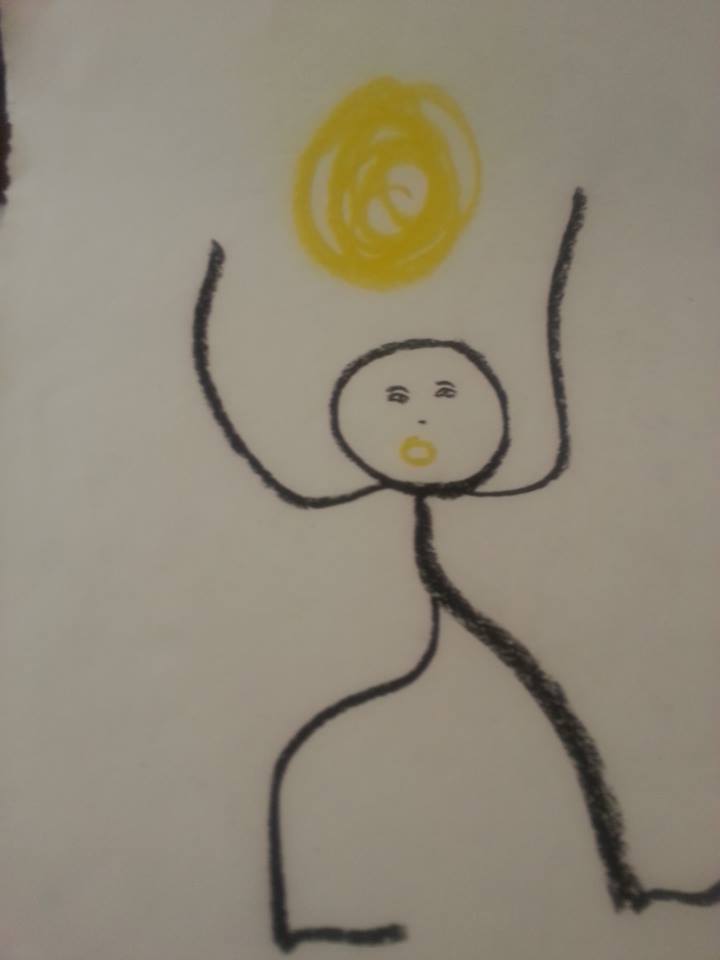 My father died over Christmas. It was unexpected and brutal in its suddenness. Pneumonia, sepsis. Like Dylan Thomas' father. Like my own partner's father a month before. I had been in the middle of one of my most creative design periods. I had just finished designing a workshop on The Power of Play and was mid way through the design of a new process.
My work has for a number of years revolved around looking at different ways to respond to volatile trading environments - finding ways for others to lead not through trying to go faster but finding more mindful and fresh eyed thinking for deliberate and impactful leadership practice. In the moments before he died I felt that I had reached some kind of fulcrum - that all of my thinking around Leadership Development was coming together in a beautiful synthesis. Using Play as a counterbalance to Command, Agility to Control, Curiosity to Plans and Energy to Time. I called it the P.A.C.E model and spent some time designing a day's workshop - Leading with P.A.C.E. - on how it plays out and what leaders can do to engage differently.And then he died.
My father died over Christmas. It was unexpected and brutal in its suddenness. Pneumonia, sepsis. Like Dylan Thomas' father. Like my own partner's father a month before. I had been in the middle of one of my most creative design periods. I had just finished designing a workshop on The Power of Play and was mid way through the design of a new process.
My work has for a number of years revolved around looking at different ways to respond to volatile trading environments - finding ways for others to lead not through trying to go faster but finding more mindful and fresh eyed thinking for deliberate and impactful leadership practice. In the moments before he died I felt that I had reached some kind of fulcrum - that all of my thinking around Leadership Development was coming together in a beautiful synthesis. Using Play as a counterbalance to Command, Agility to Control, Curiosity to Plans and Energy to Time. I called it the P.A.C.E model and spent some time designing a day's workshop - Leading with P.A.C.E. - on how it plays out and what leaders can do to engage differently.And then he died.
Death has been an extraordinary element to throw into the mix. I think it deepens one's work because Grief does not allow much time for indulgence, or for focus on frivolity. It cuts things down to the bone. But what Death also does is to allow an appreciation for Slowness, for Recovery. I started writing this tumblr on losing a parent after my father died to help me deal with my ocean of grief. It has been helpful in creating a portal into my world of memory and sadness.
I wanted to write this post because I wanted to share some insights on dealing with Grief when one is also dealing with Design. For me, the nub of the question is how does one use one's creativity positively in a space of enormous sadness? How does one Create when you just want to drown?
I have had three key insights:
1. Create out your sadness - If you can somehow create something out of your intensity of feeling, it will really balm the pain. Grief cripples one. It makes one feel insecure and doubtful about everything. That rollercoaster of Grief will make you question the worth of your work and improve it. It will blur the boundary between you and the world and in that way allow you to be open to so many perspectives you haven't thought of before. Don't just sit in it, do something with it.
If You Can
And if you can very slowly and quietly remember those moments of Play in gardens, under tented sheets when your sadness your fear your lostness disappeared, you will in that small space reimagine a life for yourself
dressed in colour and joy and at the very least, laughter.
If you can.
2. Take what you need - Grief is an extraordinary thing - an exquisite leveler. It creates a grainy telescope of understanding for the terrain of people in your life. There will be those who surprise you with their massive, all encompassing Love, others who torture you repeatedly for their one moment of giving and others who will just sit stonily and silently. Ironically your own grief will move you far away from everyone for a while. It will bleach out the colour of everything and make you want to seek out foreign lands - emotionally and physically. Take what you need from this time and from those around you. And if for now, you want nothing, that is also okay. But be clear about what you need for yourself, for your own healing however difficult it is to articulate. Do this. It will serve you well going forward.
3. Honour the dead - My father has been one of the greatest supporters of the work that I have done. I wrote a post on Gratitude for him in 2012 and those feelings remain. His dying has made me want to honour the belief he showed in me and I truly believe that I can honor him by creating my finest work.
Moving Light
There is a part of me that is terrified to feel better to know that I can cope without you
That me not wild with grief will dishonour my love for you and yours for me
But as I sit this morning in my own home drinking freshly ground coffee watching the moving light play so sweetly with the leaves
I realise that Living my life would be honouring so much of the Love you poured into mine.
At this I smile and try on a new year without You.
It is a month today after the death of my father. I am designing now using his lenses and my own. Knowing and trusting this helps me believe that the work I produce going forward will be a synthesis of both mine and his courage, insight and wisdom.
I will not go gentle into that good night, daddy.
Insights from a Lego Practitioner on the Power of Play
 One of the more significant challenges facing organisations is the question of how to develop effective organisational learning in volatile trading markets. In a world where questions can potentially be more powerful than answers, what does learning look like? If an agile workforce understands the importance of questions over answers, prototyping and iterating potential solutions and developing a healthy appreciation for problem finding when it comes to working on the right problem, what if anything needs to change in the way we do organisational design?
One of the more significant challenges facing organisations is the question of how to develop effective organisational learning in volatile trading markets. In a world where questions can potentially be more powerful than answers, what does learning look like? If an agile workforce understands the importance of questions over answers, prototyping and iterating potential solutions and developing a healthy appreciation for problem finding when it comes to working on the right problem, what if anything needs to change in the way we do organisational design?
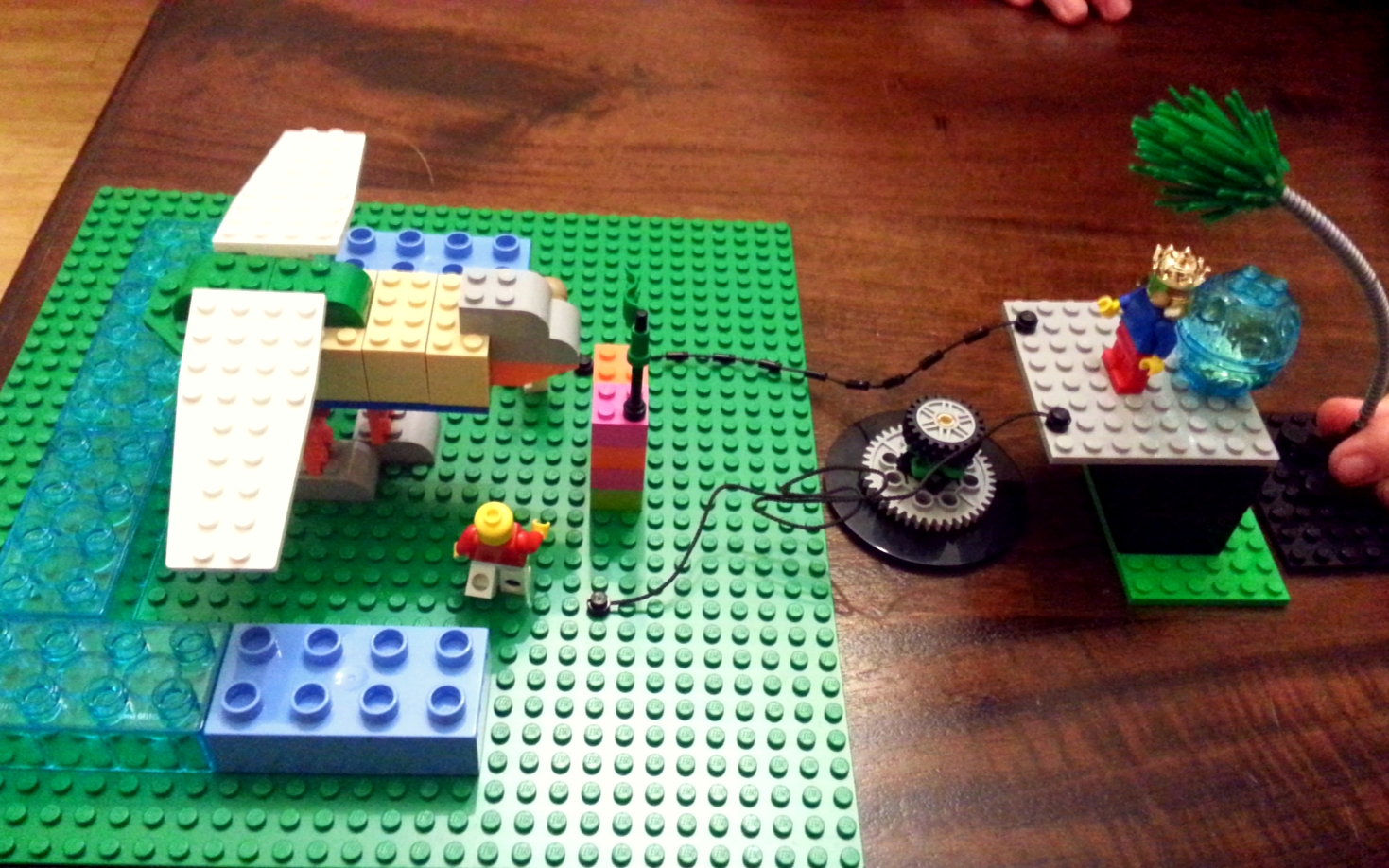 What I have observed from running strategy sessions using LEGO® SERIOUS PLAY® as a methodology is that Building requires a different starting point. Much of my work in Leadership Development has focused on reflection as the critical stance. With LEGO® SERIOUS PLAY® I have noticed something different happening. What I have found is that when one builds, one moves into a space of Play and that ego seems to fall away. What I mean by this is that due to the nature of the Lego blocks holding no inherent meaning, because one can eliminate things, break things down and rebuild, it seems to eradicate the place of judgement around oneself and ones ability to think through challenges.
What I have observed from running strategy sessions using LEGO® SERIOUS PLAY® as a methodology is that Building requires a different starting point. Much of my work in Leadership Development has focused on reflection as the critical stance. With LEGO® SERIOUS PLAY® I have noticed something different happening. What I have found is that when one builds, one moves into a space of Play and that ego seems to fall away. What I mean by this is that due to the nature of the Lego blocks holding no inherent meaning, because one can eliminate things, break things down and rebuild, it seems to eradicate the place of judgement around oneself and ones ability to think through challenges.
It is my belief that the constructionist nature of Lego helps to develop a capacity for leaders to work in a state of emergence and harness Play as a powerful driver for organisational learning.
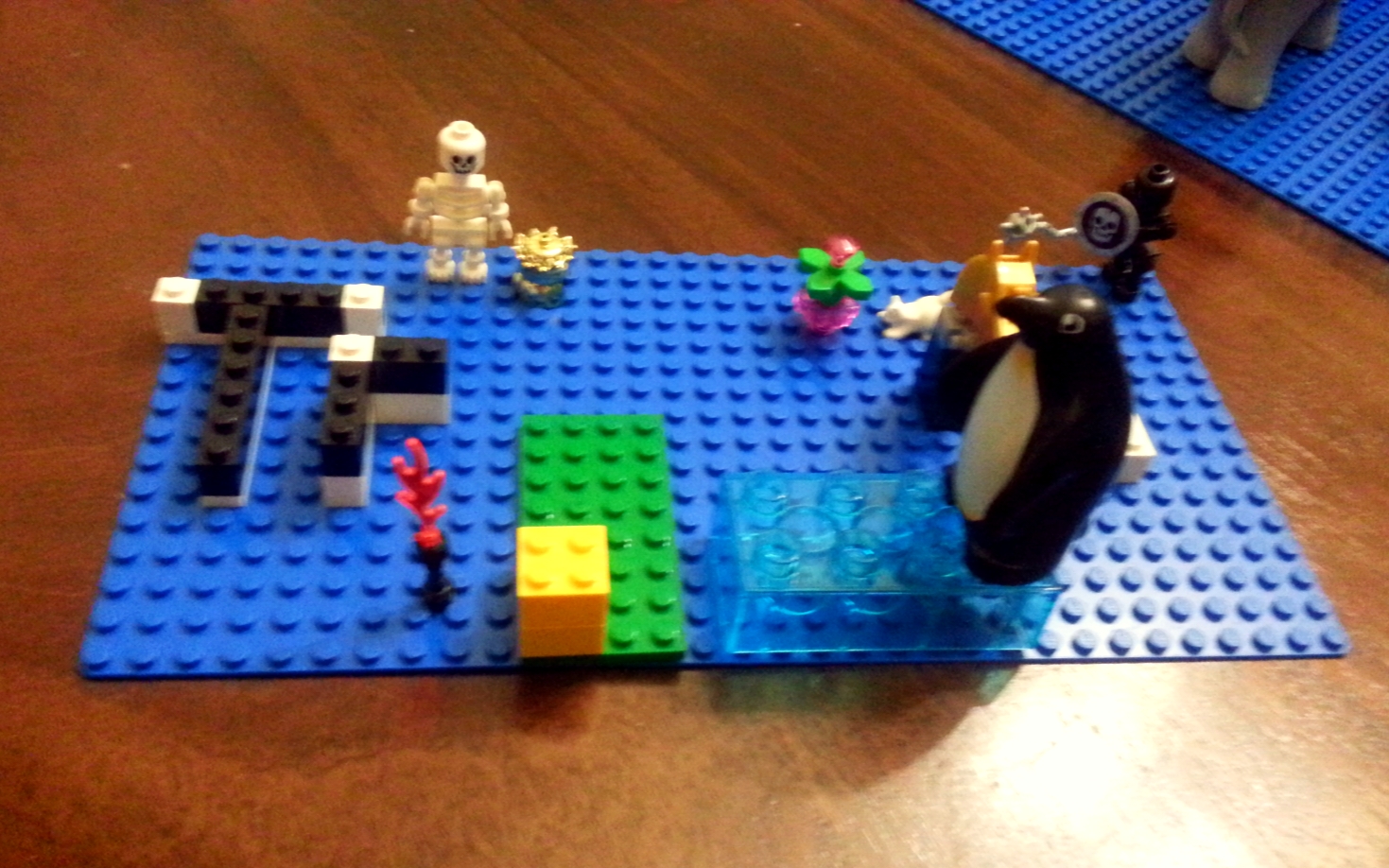 The answer always lies in the system you are building. Thus it creates a place for multiple perspectives to emerge and to be assessed without judgement. Doing these sessions has profoundly changed the way I view learning - I understand now from the impact I have seen in the thinking of the people I have worked with that it is not only in reflection that we learn but in Play, that we create and grow.
The answer always lies in the system you are building. Thus it creates a place for multiple perspectives to emerge and to be assessed without judgement. Doing these sessions has profoundly changed the way I view learning - I understand now from the impact I have seen in the thinking of the people I have worked with that it is not only in reflection that we learn but in Play, that we create and grow.
I will be talking about the Power of Play at the Knowledge Resources Chief Learning Officers conference in Johannesburg and giving a free talk on 25th October at Creative Mornings in Cape Town.


